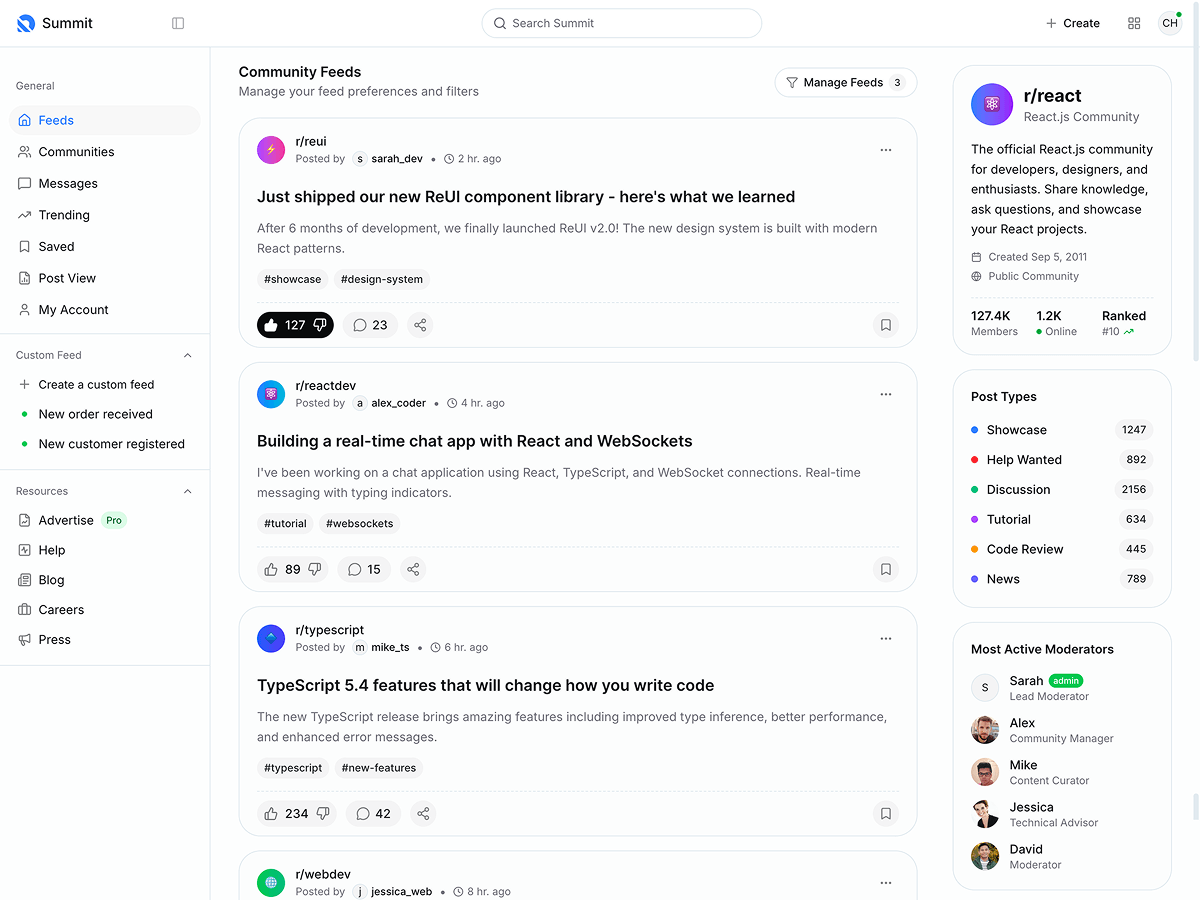Hide header in angular metronic Original dahboard
Hello
i'm using Metronic dahsboard Original (the angular version)
i want to hide the header for the desktop view so i get more space as i only need the side bar and the app-content containner
if i comment all the <app-header id="kt_app_header"> it will work but it not show sidebar_mobile_toggle in mobile version
i hope you can help me
thank you
Replies (50)
instagram reels download made simple and fast. With this tool, you can save Instagram Reels in high quality directly to your device. Just copy the reel link, paste it, and get instant access to smooth, HD downloads. Whether you want to save reels for offline viewing, inspiration, or sharing, Instagram reels download features help you keep your favorite content anytime you want. Easy, quick, and completely free.
Deep Dive Picks delivers the latest news updates, in-depth product reviews, and expert insights to keep you informed and ahead. We’re dedicated to providing honest, research-backed content that helps you make better choices. Home Security
Understanding your CGPA and converting it to a percentage is like the way we hide and hear in life. Just like sometimes knowledge is hidden in complex numbers or formulas, CGPA might seem abstract or unclear at first glance. But when you hear or decode it through a simple formula—usually multiplying by a factor like 9.5—you reveal the real performance behind the numbers. This conversion helps you see clearly how your efforts translate into percentages, making the hidden value of your academic work audible and understandable. Essentially, CGPA is the “hidden score,” and conversion is the way to “hear” your true achievement.
Nice work! Hiding the header in the Angular Metronic original dashboard really helps create a cleaner, more focused layout. It’s a small tweak, but it makes the UI feel smoother and more customizable for different project needs.
Such a great post! While going through similar fashion topics online, I came across this Women Leather Blazer collection and wanted to share it with everyone because the designs are elegant and very trendy.
Delta Executor , también conocido como Delta X, es una herramienta avanzada para ejecutar scripts personalizados en Roblox, mejorando la experiencia de juego con características como teletransportación y trucos de velocidad. Es compatible con Android, iOS y PC, y no requiere un sistema de llaves, permitiendo un acceso instantáneo. Utiliza el motor de ejecución de scripts Aorom, compatible con el 92% de UNC, lo que minimiza el riesgo de detección.
Using the right reconstitution solution is vital for restoring lyophilized powders or peptides safely and effectively. It ensures stability, purity, and accurate dosing, whether in lab research or medical applications. Options like bacteriostatic water or sterile saline are commonly used, but choosing a trusted, high-quality source makes all the difference in reliable results.
visit: hrome://flags
Assignment Mentor UK offers expert academic help, delivering tailored, high-quality assignments, essays, and dissertations to boost grades, meet deadlines, and support your academic success across diverse subjects.
Assignment Mentor UK
Please be advised that obtaining Velocity Executor from unapproved or unknown sources could endanger your Windows system before I walk you through the process of downloading it from its official
One of the most played games on Roblox right now is Blox Fruits. The game sets new records for concurrent players each time the developers release an update.
Another name for VN Video Editor is Vlog Now Video Editor. This program is for video editing, or graphic editing, as the name suggests.
as its name suggests. Cricket fans now have to have access to live matches, highlights, and exclusive content in the ever-evolving world of sports streaming.
Dooflix is a destination for entertainment with more than 25,000 of the most recent films from around the world. A famously well-known app that provides an unlimited stream of movies at your fingertips for free.
Metronic uses a centralized layout configuration (layout.config.ts or via LayoutService) to control UI elements like header, sidebar, footer, etc.
Go to your src/app/_metronic/core/configs/layout.config.ts.
Find the header configuration section and set:
ts
Copy
Edit
header: {
self: {
display: false
}
}
This will globally hide the header component.
If you're using the Metronic Angular version and want to hide the header in desktop view only (but keep it functional for mobile, especially the sidebar toggle), you shouldn't comment out the entire <app-header> component. That breaks essential responsive behavior like the sidebar_mobile_toggle.
Instead, apply a conditional class or use Angular's ngClass or ngIf to hide the header only for larger screens while keeping it active on mobile.
✅ Recommended Approach:
Use CSS with breakpoints to hide the header only on desktop:
css
Copy
Edit
@media (min-width: 992px) {
#kt_app_header {
display: none;
}
}
Or, use Angular with a screen-size check (you can use window.innerWidth or a media observer):
html
Copy
Edit
<app-header *ngIf="isMobileView"></app-header>
In your component:
ts
Copy
Edit
isMobileView = window.innerWidth < 992;
Bonus tip: If you're using Metronic's layout service or theme settings, you might also control header visibility through layout config options instead of hardcoding it.
This way, the mobile sidebar toggle will still work, and the header stays hidden only on desktop.
In today’s digital and social media era, wedding hashtags like #APwedsMJ are more than just a trend — they’re a fun and modern way for couples to celebrate and preserve their love stories. With tools like ChatGPT, creating unique, creative, and personalized hashtags has become easier than ever. When couples like AP and MJ share their story through a memorable hashtag, they’re not just announcing a wedding, they’re building a digital legacy. This trend reflects a new-age celebration of love, friendship, and memories — where every moment lives online and becomes part of something lasting.
✅ How to Hide the Header in Angular Metronic (Original Dashboard)
If you're using the Metronic Angular version and want to hide the header (e.g., the top navigation bar) on specific pages or globally, here’s how you can do it:
Option 1: Globally Hide the Header
Go to the layout configuration file:
src/app/_metronic/layout/config/layout.config.ts
Find the header section in the LayoutConfig object and set it to false:
ts
Copy
Edit
header: {
display: false,
},
Save the file. This will disable the header site-wide.
Option 2: Hide Header on Specific Pages
Open your component's TypeScript file (e.g., dashboard.component.ts).
Inject LayoutService and update the config dynamically:
ts
Copy
Edit
constructor(private layout: LayoutService) {}
ngOnInit(): void {
this.layout.setConfig({
header: { display: false }
});
}
To re-enable it on other pages, you must reset the config in those components.
Clear Cache
Sometimes Angular won’t reflect layout changes immediately. Make sure to:
Stop and restart the dev server
Clear browser cache if needed
If you're using the Metronic Angular Dashboard and want to hide the header on specific pages or entirely, it can be done with a simple layout configuration.
Step-by-Step Guide:
Open the Layout Configuration File
Navigate to:
src/app/_metronic/layout/core/config/layout.config.ts
Update the Header Visibility Setting
Find the header configuration and set display: false, like this:
ts
Copy
Edit
header: {
display: false,
},
Apply Conditionally (Optional)
If you want to hide the header only on specific routes, you can use Angular’s route data:
Define layout preferences in your routing module:
ts
Copy
Edit
{
path: 'login',
component: LoginComponent,
data: { layout: 'no-header' }
}
Then in your layout component, read the route data and toggle the header accordingly.
Result:
The header will be hidden based on your configuration, offering a cleaner interface for login pages, landing pages, or custom layouts.
Tip: Always restart the development server after layout changes for them to take full effect.
Using Metronic with Angular and want to hide the top header in specific views or globally? Whether you're customizing the layout for a clean login page or streamlining your admin interface, here's how you can do it the right way.
📠Step 1: Locate the Layout Configuration
In Angular Metronic, layout settings are typically managed via:
swift
Copy
Edit
/src/app/_metronic/layout/core/config/
Open the file:
layout.config.ts (or layout.service.ts depending on your version)
ðŸ› ï¸ Step 2: Modify Header Visibility
Find the header config object:
ts
Copy
Edit
export const LayoutConfig = {
header: {
self: {
display: true // 👈 Change this
}
},
...
};
Change display: true to:
ts
Copy
Edit
display: false
This will hide the header globally.
📌 Step 3: Hide Header for Specific Routes Only (Optional)
If you only want to hide the header on specific routes (e.g., /login), use route-based layout control in a component:
ts
Copy
Edit
import { LayoutService } from '@app/_metronic/layout';
constructor(private layout: LayoutService) {}
ngOnInit(): void {
this.layout.setConfig({
header: { self: { display: false } }
});
}
✅ Remember to reset the header visibility on other pages where it should appear.
💡 Pro Tip: Dynamic Layouts per Page
Use route guards or layout resolvers to manage header/footer/sidebar visibility based on route or user roles.
🧑💻 Need Help with Metronic Customization?
Our Angular and Metronic experts can help you implement advanced layout tweaks, role-based UI rendering, and theme customizations.
👉 [Request a Layout Change] | [Contact Our Angular Developers]
1. Identify the Header Component
In Metronic, the header is typically a part of the main layout structure. It may be present as a separate component, such as header.component.ts, or it may be inside a common layout component. You need to locate where the header is defined.
Check the app component: In your app.component.ts or layout.component.ts, you should find a reference to the header. It's often wrapped in a <header> tag or similar element.
2. Use a Flag or Variable to Toggle Visibility
To conditionally hide the header, you can create a flag or variable that will determine whether the header should be shown or hidden.
Option 1: Create a global variable In your app.component.ts or the relevant layout component, you can define a boolean variable to control the header visibility:
typescript
Copy
Edit
export class AppComponent {
showHeader: boolean = true; // Set this flag to false to hide the header
constructor() {
// You can set 'showHeader' to false conditionally based on route or other logic
}
}
Now, in your HTML (where the header is defined), you can conditionally show the header based on this flag:
html
Copy
Edit
<div *ngIf="showHeader">
<!-- Your header component or HTML code -->
</div>
Option 2: Use route-specific logic If you want to hide the header on specific routes (e.g., login page or dashboard), you can use Angular’s router to manage visibility dynamically.
In your app.component.ts:
typescript
Copy
Edit
import { Component } from '@angular/core';
import { ActivatedRoute, NavigationEnd, Router } from '@angular/router';
import { filter } from 'rxjs/operators';
@Component({
selector: 'app-root',
templateUrl: './app.component.html',
})
export class AppComponent {
showHeader: boolean = true;
constructor(private router: Router) {
// Listen to route changes and hide the header based on specific routes
this.router.events
.pipe(
filter((event) => event instanceof NavigationEnd)
)
.subscribe((event: NavigationEnd) => {
if (event.urlAfterRedirects === '/login') {
this.showHeader = false;
} else {
this.showHeader = true;
}
});
}
}
This will hide the header when the URL is /login and show it for other routes.
3. Update the HTML Template
In your HTML template (likely app.component.html or layout.component.html), wrap the header section in an ngIf directive to conditionally render it:
html
Copy
Edit
<!-- Conditionally show the header -->
<div *ngIf="showHeader">
<app-header></app-header> <!-- or your header code -->
</div>
4. Use Route Guards for More Complex Logic (Optional)
If you need more control over when to hide or show the header based on user roles, authentication, or other conditions, you can also use route guards to implement logic before routing to a page.
For example, you could create a guard that checks for specific routes and decides whether the header should be visible or hidden.
Conclusion:
To hide the header in the Metronic Angular Dashboard, you can use the following steps:
Identify where the header is defined.
Create a condition (using a boolean flag or route logic) to control whether the header should be displayed.
Use *ngIf to conditionally render the header in your template.
Here's a Mounjaro Dose Chart:
Week 1: 2.5 mg
Week 2-4: 5 mg
Week 5-8: 7.5 mg
Week 9 and beyond: Up to 15 mg
This gradual increase helps your body adjust to Mounjaro. Always follow your doctor's recommendations for your specific needs.
Step-by-Step Guide
Metronic Angular is one of the most powerful and flexible admin templates used by Angular developers worldwide. But sometimes, for specific pages (like login, register, or custom modals), you may want to hide the default header (also called the top bar).
This quick guide shows you how to hide the header in Angular version of the Metronic Original dashboard layout.
Step 1: Locate the Layout Configuration File
Metronic Angular uses a layout configuration system stored in a TypeScript service. You can dynamically control the visibility of different layout components.
Navigate to:
arduino
Copy
Edit
src/app/_metronic/layout/config/layout.config.ts
Here you’ll find the default layout configuration object that looks like this:
ts
Copy
Edit
export const LayoutConfig: LayoutConfigModel = {
header: {
self: {
display: true, // 👈This controls the header visibility
},
},
...
}
Step 2: Set Header Visibility to false
To hide the header globally, just change:
ts
Copy
Edit
display: false
If you want to hide it only on certain routes, proceed to the next step.
Step 3: Hide Header Conditionally Based on Route
If you want to hide the header only on login/register/etc, you can modify the layout dynamically in the LayoutService.
Example:
In:
swift
Copy
Edit
src/app/_metronic/layout/core/services/layout.service.ts
You can inject Router and listen to route changes like this:
ts
Copy
Edit
constructor(private router: Router) {
this.router.events.subscribe(event => {
if (event instanceof NavigationEnd) {
if (event.url.includes('/login') || event.url.includes('/register')) {
this.setConfig({ header: { self: { display: false } } });
} else {
this.setConfig({ header: { self: { display: true } } });
}
}
});
}
This dynamically hides the header on specific pages only.
Optional: Hide Toolbar, Aside, Footer Too
If you're designing a minimal layout, you can hide other parts too:
ts
Copy
Edit
this.setConfig({
header: { self: { display: false } },
aside: { self: { display: false } },
footer: { self: { display: false } }
});
Best Practices
Tip Why it Matters
Use route-based logic Keeps the layout flexible
Test on mobile + desktop Ensure hidden UI doesn't break layout
Use ChangeDetectorRef If layout doesn't update immediately
Avoid hiding via CSS only Use layout service to keep structure clean
Conclusion
Hiding the header in the Angular Metronic dashboard is cleaner and more scalable when done using the layout service and Angular router logic. Whether you're building a custom login page, an embedded app view, or a print-ready page — this method gives you total layout control.
Tags: #AngularMetronic #MetronicHideHeader #MetronicLayoutService #AngularDashboardUI #MetronicCustomization
To hide the header in the Angular Metronic original dashboard, update the layout config to disable header display. Useful when customizing UI or integrating "consulta saldo movilnet" functionality. Example: this.layoutConfigService.setConfig({ header: { self: { display: false } } });










